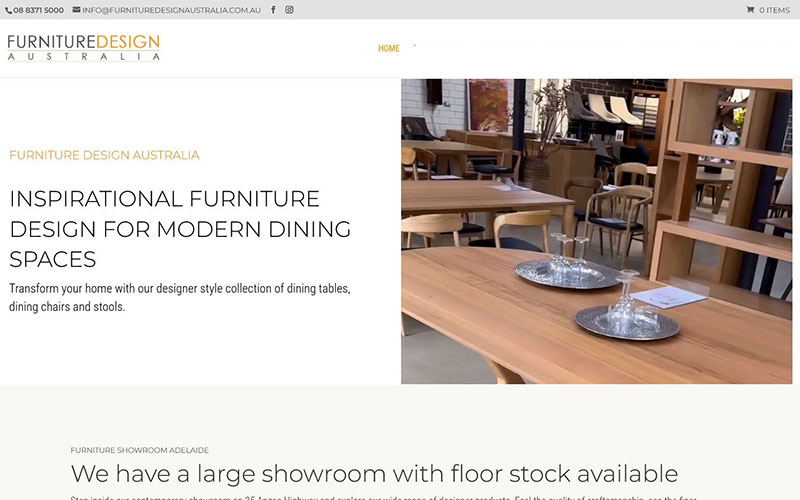
Ecommerce website design in Adelaide

Ecommerce website design in Adelaide

Ecommerce website design in Adelaide

Ecommerce website design in Adelaide
Ecommerce shipping, a crucial element to plan before building your website

How to best plan your ecommerce shipping strategy
How to distribute your products and deciding the cost of shipping are fundamental aspects of ecommerce that require careful planning and strategic decision-making before your ecommerce website is built. However, these critical aspects are often overlooked until the final stages of website development.
As a small business owner, it is crucial to establish your shipping and distribution strategy upfront to ensure the best possible customer experience with a transparent, smooth, and informative purchase process. The approach should also consider a cost-effective way for your ecommerce shop to do business online.
Your ecommerce web designer is responsible for bringing your vision to life, but the direction and decisions should come from you. Collaborate with your website designer to find the best shipping methods and tools that align with your business goals.
Why is ecommerce shipping important?
Two main points highlight the importance of planning your shipping strategy early.
1. Customer experience
First, shipping is a critical component of the ecommerce customer experience. Your customers want to know the exact shipping cost as early as possible during checkout, not after going through the entire checkout. Unexpected shipping costs at the final stage can lead to cart abandonment and lost sales.
2. Business profitability
Second, understanding the pricing strategy is essential for any small business. Pricing is the combination of the price of your product, your cost of goods, and the shipping cost. Not thinking through how your shipping cost may add unexpected costs to your business can impact your business profitability.
Therefore, it’s essential to think about your shipping strategy early on to avoid these pitfalls.
This blog will guide you through what you need to consider for a successful ecommerce shipping strategy before your website is built.
How does ecommerce shipping work?
Ecommerce shipping involves the process of delivering products purchased online to the customer’s location. It includes several elements, such as packaging, labelling, and transporting products to their final destination. Efficient ecommerce shipping ensures that customers receive their orders on time and in good condition, contributing to a positive shopping experience and repeat business.
Determine your ecommerce shipping costs
Deciding how much to charge for shipping is a business decision that impacts your overall pricing strategy. You need to consider factors such as the weight and dimensions of your products, the destination, and the geographical location of your customers. With these in mind, you may consider a flat-rate shipping fee or free shipping for orders above a certain amount. The questions and considerations are many, so a thoughtful and careful approach is necessary.
A practical step-by-step approach
1. Research your shipping options
There are many shipping options with different post and delivery providers in Australia. To guide you through the thought process, I have provided two popular choices, each offering unique benefits and some limitations. As you read through, you are likely to find critical points that are important for your business and that will help you create an effective shipping strategy that works for your business.
Therefore, the first step you need to take is to research different shipping options and company providers to find the best fit for your business. Here are some examples from these two companies.
Australia Post
Benefits:
- Wide coverage across urban and rural areas.
- Various shipping options like standard, express, and international.
- Easy integration with ecommerce platforms through plugins.
- A trusted brand that enhances customer confidence.
How It Works:
- Set up an account with Australia Post and integrate their services using a plugin.
- Shipping costs are calculated based on weight, dimensions, and destination.
- Tracking services are available for most options.
Limitations:
- Costs can be high, especially for express or international shipping.
- Managing multiple shipping options and rates can be complex.
Sendle
Benefits:
- Flat-rate pricing simplifies cost structure.
- Carbon-neutral shipping options.
- Door-to-door delivery with convenient pick-up services.
- Easy integration with ecommerce platforms using plugins.
How It Works:
- Create an account with Sendle and integrate their services using a plugin.
- Flat-rate pricing based on package size and destination zones.
- Tracking is provided for all shipments.
Limitations:
- May not cover all rural areas in Australia.
- Pricing structure is more advantageous for higher shipping volumes.
2. Decide on your shipping rules
After researching shipping options, establish clear rules to avoid confusion and ensure customer transparency. You can consider different rates for various locations (urban vs. rural) and decide whether to offer expedited shipping. Simple shipping rules can prevent customer dissatisfaction during checkout.
3. Order confirmation and notifications
For customer shopping online, it is essential to receive order confirmations and notification emails once their order is processed. These emails inform customers about their order status and reinforce trust in your brand. An e-commerce system like WooCommerce will automatically set up and send these notifications. Additionally, all orders are stored on the backend of your website for easy management and tracking. This setup helps you stay organized and provides a record of all transactions.
4. Provide Shipping Cost Upfront
Customers appreciate knowing the shipping costs upfront rather than encountering unexpected charges at checkout. Consider displaying shipping costs early in the shopping process to enhance the customer experience and reduce cart abandonment. This transparency helps build trust and can lead to higher conversion rates. For instance, you can show estimated shipping costs on the product page or shopping cart before the customer checks out.
5. Consideration of free shipping
Offering free shipping can be an incentive for customers to complete their purchases. You need to decide from a business perspective if it makes sense to set a minimum order value to qualify for free shipping, which encourages customers to spend more. This strategy is straightforward and can be implemented within most e-commerce systems. Free shipping can increase sales but also improve customer satisfaction. If you do this, you need to think about the order value; for example, should you offer free shipping for orders over $100, making it an attractive option for customers to buy more to reach the threshold?
By addressing these critical aspects of e-commerce shipping, you can create a seamless and efficient shipping process that enhances the overall shopping experience for your customer. You can also consider what it means for your total product and distribution cost.
6. Integrate Payment Options
You also need to integrate various payment options on your cart and checkout pages to enhance customer convenience. Common payment methods include:
Credit/debit cards
Payments can be made directly on your site without redirection.
Cash at pickup
Useful for local customers.
Direct bank transfers
Allows customers to transfer funds directly.
PayPal
Paypal is a trusted online bank used by many online shoppers.
Recommended Payment Gateway: Stripe
Benefits
- Free to set up with slightly lower transaction fees than PayPal.
- Funds are transferred directly to your bank account.
- Easy integration with ecommerce platforms.
- Provides robust security features.
Set up a Stripe account and connect it to your ecommerce site to enable secure payments.
7. Shipping plugins and tools
Discuss your decisions with your website designer once you are clear about your ecommerce shipping strategy. Integrating shipping plugins with your ecommerce platform can automate calculations and streamline operations.
For WooCommerce users, plugins like Table Rate Shipping for Woocommerce and Australia Post Shipping Method are popular choices. These plugins can automate shipping cost calculations based on product dimensions and weight, saving time and reducing errors. Be aware that these plugins might require additional setup and annual fees. Choose the right tools that fit your business needs and budget.
Creating your own ecommerce shipping strategy
Deciding on your shipping strategy is a fundamental aspect of ecommerce business that require careful planning and a practical approach for your customers. By doing this work before the website is finally built will safe you time, cost and lead to a smooth and cost-effective check out process for your prospective customers.

